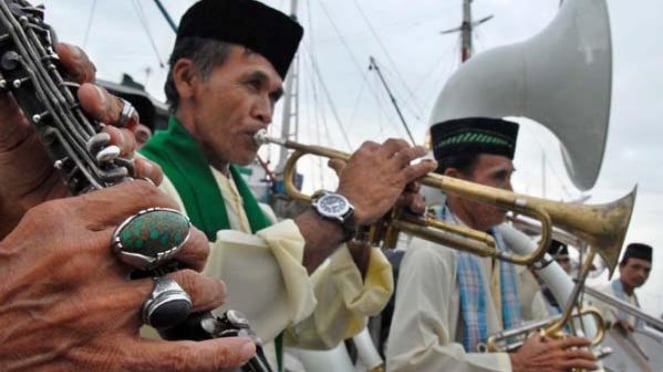Getting to Know Ten Traditional Musical Instruments from Betawi
- VIVA/M Ali Wafa
VIVA – Indonesia is known for its extraordinary cultural wealth; one is traditional musical instruments that have been passed down from generation to generation. Traditional musical instruments were made in certain areas, so musical instruments from one region to another must be different.
Just like other regions, the Betawi tribe from Jakarta also has a variety of distinctive traditional musical instruments. The role of Betawi musical instruments deserves to be preserved. Well, here are ten traditional musical instruments from Betawi which are the result of acculturation from various cultures.
1. Gambang
Gambang
- Tangkapan layar instagram/batik_semar
Gambang is a traditional Betawi musical instrument made of wooden blades that open 18 blades and are shaped like a boat.
The woods commonly used to make Gambang are cinnamon, suangking, and ahlu batu. Each wooden slat can produce a different tone according to its size. Gambang works as an accompanist in the art of Gambang Kromong.
2. Kromong
Kesenian Gambang Kromong.
- http://www.reinha.com
Kromong is also known as bonang. If the Gambang is made of wood, then the kromong is made of metal. The way to play the Gambang and the Kromong instrument is the same as being hit. The function of the Kromong or bonang is to carry the main melody of other musical instruments.
3. Gambang Rancag
Gambang Rancag consists of two elements, namely Gambang and Rancag. Gambang means the accompanying music and design as the story tells. Gambang rancag is a song that tells Betawi folklore in the form of related rhymes. Gambang Rancag generally performs good plays such as Si Pitung, Si Jampang, and Si Angkri.
4. Marawis
Kerajinan Alat Musik Marawis
- Antara/Wahyu Putro A
Marawis is a traditional musical instrument as a result of a blend of culture between Betawi culture and Middle Eastern culture. This Betawi musical instrument is famous in Indonesia, even been adapted as a Bengkulu musical instrument.
Marawis has a shape resembling a tambourine, but there are differences in shape. Marawis also has a stockier shape than the tambourine which has a flatter shape.
Marawis is divided into three parts based on the stroke or tone produced. Zapin has a slower tone. Sarah, has a more vibrant rhythm and tone. Zahefah has a lively tone or rhythm but is more suitable for accompanying religious songs.
5. Rebana Hadro
The Rebana Hadro has a size of 25 cm – 35 cm and is larger than the Ketipring tambourine. Three pairs of metal circles are attached to the wooden cladding to function as krecek. The function of this tambourine is as Bawa, Ganjil/Seling, and Gedug.
6. Gender
Gender is the same as Kromong which is made of metal. In addition to bronze, gender is usually also made of brass or iron. Gender consists of 10 to 14 pieces of metal planks formed in a box made of wood. Gender works as an accompaniment and leader in a song.
7. Kecrek
Alat Musik Saron
- Tangkapan Layar: Instagram
Betawi kecrek uses thin metal made of iron, brass, or copper which usually comes in 2 or 4 pieces. This metal is arranged on a handle or board made of wood with a small stick as a medium for hitting it. Kecrek has a function as a giver of cues, utilization, and as an accompaniment in an art performance.
8. Gong
Not only well-known in the Javanese, but the gong is also a significant element in musical performances for the Betawi people. In metal, musical instruments made of this function as a tool for religious rituals as well as traditional ceremonies.
9. Gambus
Gitar gambus tradisional warga di Manggarai Barat Nusa Tenggara Timur
- VIVA.co.id/Harry Siswoyo
Gambus is a stringed instrument that has strings or strings that are opened from 3 to 12 strings. The more strings you use, the more different tones you can produce. The function of the gambus as an accompaniment in a show.
10. Tanjidor
Pemusik Tanjidor ikut meramaikan acara.
- Antara/Fanny Oktavionus
The tanjidor musical instrument from Betawi is still popular now. This instrument was originally played by Dutch slaves in Batavia. Tanjidor is a musical instrument played by the group.
The Tanjidor Orchestra developed in the 19th century when the Betawi community was born. Tanjidor consists of various musical instruments. Tanjidor is played along with folk songs such as Jali-Jali.
This musical art is played during circumcisions, and weddings, reducing Indonesian Independence and the new year. The Tanjidor Orchestra plays while walking around the home environment.







































